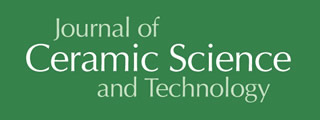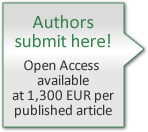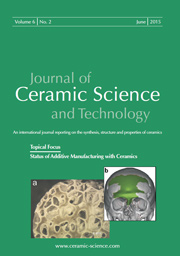Articles
All articles | Recent articles
Thermochemical Calculations of the Stability of Ti2AlC in Various Atmospheres
M. Stumpf, T. Fey, P. Greil
Department of Materials Science (Glass and Ceramics), University of Erlangen-Nuernberg, Martensstr. 5, D-91058 Erlangen, Germany
received April 11, 2016, received in revised form May 24, 2016, accepted June 20, 2016
Vol. 7, No. 3, Pages 223-228 DOI: 10.4416/JCST2016-00029
Abstract
The thermochemical stability of the MAX phase Ti2AlC under vacuum, inert Ar, pure O2 and N2 and a reactive air atmosphere was explored based on thermochemical equilibrium calculations. A dataset on the enthalpy of formation, standard molar entropy and the temperature variation of the heat capacities of Ti2AlC and TiC0.5 was derived from thermochemical properties given in the literature and implemented in the software package HSC Chemistry. In inert atmosphere Ti2AlC decomposes peritectically into solid TiC0.5 and a liquid Al-rich phase at approximately 1673 °C whereas in vacuum (1 mPa) dissociation into solid TiC0.5 and an Al gas phase is observed at a significantly lower temperature of 984 °C. When Ti2AlC is exposed to air as well as pure O2, solid Al2O3 and TiO2 will form with the carbon being oxidized to gaseous CO and CO2. At very low air content, however, the calculations show TiC0.5 and AlN as the prevailing reaction products with small fractions of Al2O3. In a pure nitrogen atmosphere Ti2AlC is nitrided to AlN, TiN and residual carbon.
![]() Download Full Article (PDF)
Download Full Article (PDF)
Keywords
MAX phase, thermochemical calculations, atmosphere stability
References
1 Barsoum, M.W., Brodkin, D., El-Raghy, T.: Layered machinable ceramics for high temperature applications, Scripta Metall. Mater., 36, 535 – 541, (1997).
2 Barsoum, M.W.: The Mn+1AXn Phases: a new class of Solids; thermodynamically stable nanolaminates, Prog. Solid State Chem., 28, 201 – 281, (2000).
3 Barsoum, M.W.: Oxidation of Tin+1AlXn (n=1 – 3 and X=C, N), J. Electrochem. Soc., 148, C544 – C550, (2001).
4 Sonestedt, M., Frodelius, J., Sundberg, M., Hultman, L., Stiller, K.: Oxidation of Ti2AlC bulk and spray deposited coatings, Corros. Sci., 52, 3955 – 3961, (2010).
5 Sundberg, M., Malmqvist, G., Magnusson, A., El-Raghy, T.: Alumina forming high temperature silicides and carbides, Ceram. Int., 30, 1899 – 1904, (2004).
6 Lin, Z., Zhuo, M., Zhou, Y., Li, M., Wang, J.: Microstructures and adhesion of the oxide scale formed on titanium aluminum carbide substrates, J. Am. Ceram. Soc., 89, 2964 – 2966, (2006).
7 Frodelius, J., Johansson, E.M., Córdoba, J.M., Odén, M., Eklund, P., Hultman, L.: Annealing of thermally sprayed Ti2AlC coatings, Int. J. Appl. Ceram. Tec., 8, 74 – 84, (2011).
8 Pang, W.K., Low, I.M.: Diffraction study of thermal dissociation in the ternary Ti-Al-C system, J. Aust. Ceram. Soc., 45, 30 – 33, (2009).
9 Pietzka, M.A., Schuster, J.C.: Phase equilibria in the quaternary system Ti-Al-C-N, J. Am. Ceram. Soc., 79, 2321 – 2330, (1996).
10 Yang, H.J., Pei, Y.T., Rao, J.C., De Hosson, J.T.M., Li, S.B., Song, G.M.: High temperature healing of Ti2AlC: on the origin of inhomogeneous oxide scale, Scripta Mater., 65, 135 – 138, (2011).
11 Bei, G.P., Pedimonte, B.J., Pezold, M., Ast, J., Fey, T., Goeken, M., Greil, P.: Crack healing in Ti2Al0.5Sn0.5C-Al2O3 composites, J. Am. Ceram. Soc., 98, 1604 – 1610, (2015).
12 Duong, T., Gibbons, S., Kinra, R., Arróyave, R.: Ab-initio approach to the electronic, structural, elastic, and finite-temperature thermodynamic properties of Ti2AX (A=Al or Ga and X=C or N), J. Appl. Phys., 110, 093504, (2011).
13 Drulis, M.K., Drulis, H., Gupta, S., Barsoum, M.W., El-Raghy, T.: On the heat capacities of M2AlC (M=Ti, V, Cr) ternary carbides, J. Appl. Phys., 99, 093502, (2006).
14 Barsoum, M.W., Salama, I., El-Raghy, T., Golczewski, J., Seifert, H.J., Aldinger, F., Porter, W.D., Wang, H.: Thermal and electrical properties of Nb2AlC, (Ti, Nb)2AlC and Ti2AlC, Metall. Mat. Trans. A, 33, 2775 – 2779, (2002).
15 Lipatnikov, V.N., Gusev, A.I.: Effect of ordering on the structure and specific heat of nonstoichiometric titanium carbide, J. Exp. Theor. Phys. Lett., 69, 669 – 675, (1999).
16 Gusev, A.I.: Phase equilibria, phases and compounds in the Ti-C system, Russ. Chem. Rev., 71, 439 – 463, (2002).
17 Barsoum, M.W.: MAX phases: Properties of machinable ternary carbides and nitrides. Wiley-VCH Verlag GmbH & Co KGaA, Weinheim, 2013.
18 Witusiewicz, V.T., Hallstedt, B., Bondar, A.A., Hecht, U., Sleptsov, S.V., Velikanova, T.Ya.: Thermodynamic description of the Al-C-Ti system, J. Alloy. Compd., 623, 480 – 496, (2015).
19 Frodelius, J., Lu, J., Jensen, J., Paul, D., Hultman, L., Eklund, P.: Phase stability and initial low-temperature oxidation mechanism of Ti2AlC thin films, J. Eur. Ceram. Soc., 33, 375 – 382, (2013).
20 Li, S., Hu, S., Hee, A.C., Zhao, Y.: Surface modification of a Ti2AlC soft ceramic by plasma nitriding treatment, Surf. Coat. Techn., 281, 164 – 168, (2015).
21 Cui, B., Jayaseelan, D.D., Lee, W.E.: Microstructural evolution during high-temperature oxidation of Ti2AlC ceramics, Acta. Mater., 59, 4116 – 4125, (2011).
22 Duwez, P., Odell, F.: Phase relationships in the binary systems of nitrides and carbides of zirconium, columbium, titanium, and vanadium, J. Electrochem. Soc., 97, 299 – 304, (1950).
Copyright
Göller Verlag GmbH


